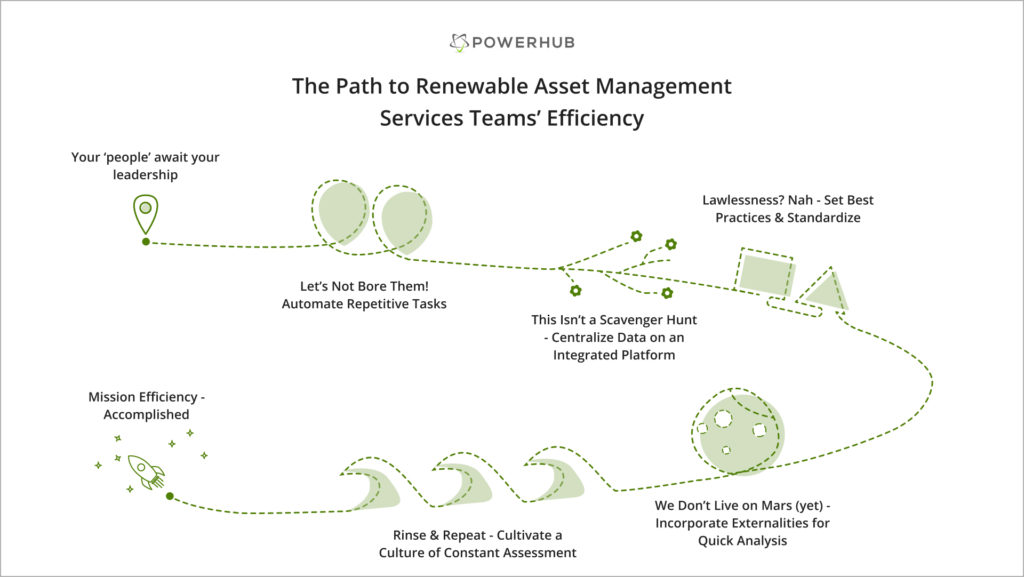Your assets are in good shape. You’ve invested a whole lot to get your renewable energy project off the ground. You have the tools necessary to make it work. What now? Now you lead. You lead a dedicated renewable asset management services team that will monitor these projects and make them profitable.
The ‘people’ component of an asset manager’s responsibility is, perhaps, the most engaging aspect of management. Where we talk about the efficiency and performance of turbines and solar panels, we should also draw our attention to the people dedicating long hours to manage them. Are they productive, motivated, and charged up?
Have you equipped your renewable asset management services team with the tangible and intangible triggers they need to work better? Or is their valuable time still tied up in mundane tasks? #FoodForThought
The Path to Renewable Asset Management Services Teams’ Efficiency

Let’s Not Bore Them! Automate Repetitive Tasks
This one always takes the top spot. You’ll be surprised to realize how much time you have on your hands once you invest in automating software. As an asset manager, you are incharge of various activities and processes, a huge chunk of which can be automated.
For instance, our research and experience working in renewable circles has revealed that inefficient teams are sometimes spending up to 40 hours a month for invoicing alone. That’s just too much time tied up in one activity.
A renewable asset management platform like PowerHub helps you set triggers and parameters to generate reports and automate repetitive invoicing.
The result? A spike in productivity anywhere between 60%-85%. Now that’s a number you can put on that next report.
This Isn’t A Scavenger Hunt – Centralize Data on an Integrated Platform
The one thing a manager has in abundance is data. Numbers pouring out of various performance and maintenance systems will always surround you. But is there a central hub for this data? Have you considered integrating the various tools that generate this information?
Gathering performance, maintenance, spare part ordering, and other utility data in a central hub is the core purpose of an intelligent asset management software. It’s powerful integrations help make teams efficient by reducing the amount of time and resources you need to manage your wind or solar plant. It keeps team members on the same page, and information on your fingertips.
If you still have a piece of paper laying around with a hastily scribbled note that is super important, your renewable asset management services can do with a bit of makeover.
Lawlessness? Nah – Set Best Practices & Standardize
Just like an abundance of data, there’s a lot of procedures and protocols involved when managing millions of dollars’ worth of assets. Therefore, team members working on the same solar project, or even across portfolios, can benefit from a standard set of best practices.
Standardizing the use of data and protocols tells your team what to expect, and how to behave under unique circumstances. It helps them save time and use their resources valuably.
We Don’t Live on Mars (yet) – Incorporate Externalities for Quick Analysis
What’s unique about renewables as an industry is the presence of the biggest externality, the weather. Renewable energy critics hold this close to heart. They think the agenda for majority renewables is purely aspirational because solar and wind power are intermittent sources.
What brings an acceptable level of standardization is accepting these externalities, and making them part of performance measurements. The same also helps make renewable asset management services teams efficient because they present a clearer picture of performance standards.
Asset management teams are better equipped to spot trends once the weather is part of the equation. They can isolate factors like equipment malfunctions to link them to underperformance. Consequently, they can prepare for downtime, and build a robust maintenance strategy to up performance.
Rinse & Repeat – Cultivate a Culture of Constant Assessment
It might sound counterintuitive, but setting an example of constantly assessing performance helps your team stay ahead of the curve. You’ve probably heard a thousand times, ‘nothing is constant in the world of renewables.’ Cliché, but true.
Therefore, with constant re-assessment and re-forecasting, an asset manager actually ends up saving time. His team is better prepared for unplanned weather disruptions, downtime losses, and compliance obligations.
How Productive Is Your Team?
Whether you lead a team of 10 or 100, helping it becoming efficient should be a top priority for you. It’s not always easy. You may not have their buy-in to use a new software, or to begin the digitalization journey altogether.
In these instances, a discussion on improving efficiency can be highly valuable. For their own personal development, and for the performance of your assets.




